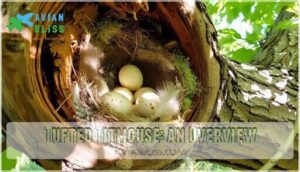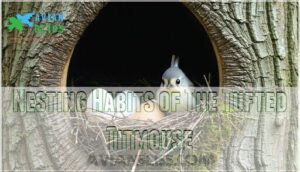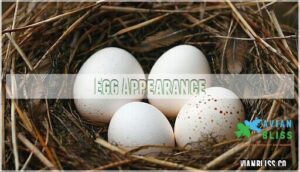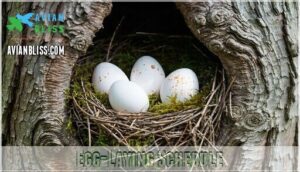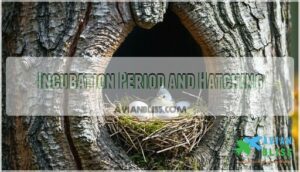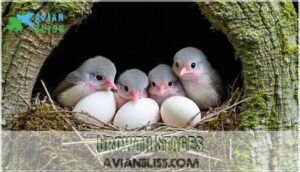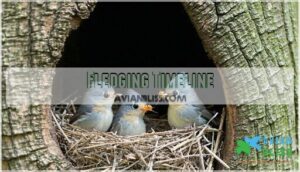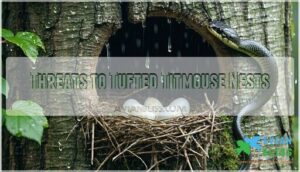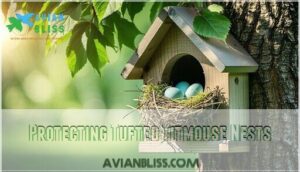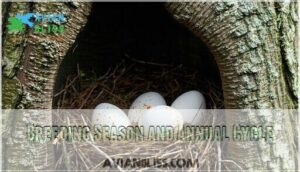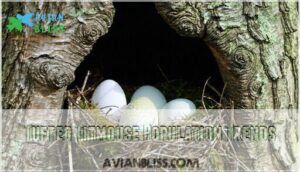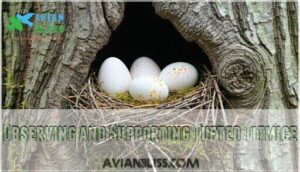This site is supported by our readers. We may earn a commission, at no cost to you, if you purchase through links.
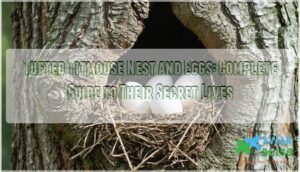
These clever birds line their cozy homes with soft animal hair—they’ll even pluck fur from live animals. The female lays 5-8 white eggs with delicate brown speckles, each about three-quarters of an inch long.
She’ll incubate them for roughly 17 days while her mate brings food.
These cavity-nesters choose old woodpecker holes or natural tree hollows in deciduous forests across eastern North America.
Their secretive nesting behavior and unique hair-collecting habits make them fascinating neighbors with surprising tricks up their feathered sleeves. They are clever birds with cozy homes.
Table Of Contents
- Key Takeaways
- Tufted Titmouse: an Overview
- Nesting Habits of The Tufted Titmouse
- Tufted Titmouse Eggs
- Incubation Period and Hatching
- Nestling Development and Care
- Threats to Tufted Titmouse Nests
- Protecting Tufted Titmouse Nests
- Breeding Season and Annual Cycle
- Tufted Titmouse Population Trends
- Observing and Supporting Tufted Titmice
- Frequently Asked Questions (FAQs)
- How long do titmouse babies stay in the nest?
- What does a Tufted Titmouse nest look like?
- How many eggs does a Tufted Titmouse lay?
- What do titmouse bird eggs look like?
- How long does it take for Tufted Titmouse eggs to hatch?
- What kind of nest does a Tufted Titmouse have?
- How many babies do Tufted Titmouse have?
- Can tufted titmice reuse the same nest?
- How do tufted titmice select nesting sites?
- Do tufted titmice migrate during winter?
- Conclusion
Key Takeaways
- You’ll find their nests in tree cavities 3-90 feet high – Tufted titmice prefer abandoned woodpecker holes or natural hollows around 35 feet up, choosing spots that offer protection from predators while remaining accessible for feeding trips.
- They lay 5-8 white eggs with brown speckles – The female produces distinctively marked eggs about three-quarters of an inch long, which she’ll incubate for approximately 17 days while her mate provides food.
- These birds use unique nesting materials – You’ll discover they line their nests with soft animal hair, moss, and plant fibers, often plucking fur directly from live animals to create cozy homes for their young.
- Their secretive breeding behavior makes observation challenging – Tufted titmice are cavity nesters with hidden nesting sites, making them fascinating but elusive neighbors whose breeding success depends on finding suitable tree hollows in deciduous forests.
Tufted Titmouse: an Overview
You’ll recognize these charming gray birds by their distinctive crested heads and black button eyes as they dart through deciduous forests across the eastern United States.
These cavity nesters have fascinating breeding behaviors that reveal remarkable adaptability in their choice of nest sites and materials.
Physical Description
Anyone can spot a tufted titmouse by these distinctive plumage details and distinct markings:
- Prominent gray crest that stands upright
- Large, dark eyes contrasting with pale face
- Compact black bill perfect for seed-cracking
- Rusty-orange flanks against white underparts
These six-inch songbirds show no size variation between sexes. Their soft gray plumage creates uniform nest appearance year-round.
Juvenile appearance mirrors adults, though slightly duller. Their signature vocalizations include the familiar "peter-peter-peter" call that echoes through eastern woodlands, characterized by a distinctive sound.
Habitat and Range
You’ll discover tufted titmice throughout the eastern United States, where their breeding range continues expanding northward into Canada.
These adaptable birds call deciduous woodlands home while showing remarkable Urban Adaptation to suburban neighborhoods.
| Forest Preferences | Range Expansion | Climate Impact |
|---|---|---|
| Oak-hickory forests | Moving north 50+ miles | Warmer winters aid survival |
| Mixed hardwood stands | Following habitat corridors | Extended breeding seasons |
| Edge habitats preferred | Urbanization creates opportunities | Shifting food availability |
| Dense canopy coverage | Climate change facilitates spread | Weather pattern changes |
| Multi-story vegetation | Human-modified landscapes | Temperature tolerance limits |
Habitat Loss threatens some populations, yet tufted titmice adapt well to human-modified environments, thriving where suitable nesting cavities exist.
Behavior
Tufted titmice exhibit complex bird behavior patterns throughout their lives.
These small acrobats demonstrate remarkable foraging behavior as they hang upside-down from branches to capture insects and seeds.
Key behavioral characteristics include:
- Vocalizations – Their distinctive "peter-peter-peter" calls establish social hierarchy and communicate with mates
- Territory defense – Pairs aggressively protect breeding season territories from intruders and competitors
- Courtship rituals – Males perform elaborate displays while females select ideal nesting habits locations
- Nest building – Both partners collaborate in construction, demonstrating coordinated avian reproduction strategies
These energetic birds form lifelong pair bonds.
Their songs are vital for territorial defense.
Nesting Habits of The Tufted Titmouse
When you watch tufted titmice during breeding season, you’ll discover their remarkable adaptability in finding the perfect cavity for raising their young.
These resourceful birds transform abandoned woodpecker holes and nest boxes into cozy homes using an impressive variety of materials, showcasing their remarkable ability to create a suitable environment.
From abandoned woodpecker holes to backyard nest boxes, tufted titmice prove that home truly is where the heart is.
Nest Site Selection
These birds’ nest site selection involves careful inspection of potential cavity nesting locations.
You’ll observe them evaluating nesting cavities based on specific criteria that guarantee successful reproduction.
Their cavity preference includes abandoned woodpecker holes, natural tree hollows, and nesting boxes mounted 4-55 feet above ground.
Many options are available for purchasing quality boxes.
Tufted titmouse pairs demonstrate remarkable site competition behaviors when securing prime real estate.
They’ve shown impressive urban adaptation, utilizing manmade structures when natural habitat availability becomes limited.
Key selection factors include:
- Nest height positioning between 4-55 feet for ideal predator protection
- Cavity depth and entrance hole diameter suitable for their body size
- Proximity to reliable food sources within their territory
- Strategic location offering concealment from potential nest competitors
Nest Building Process
Once you’ve selected the perfect cavity, the nest building process begins. Both males and females participate in cooperative building, though females handle most construction work.
The nest building process involves several key activities. Cavity inspection continues throughout the 4-11 day nest duration. Material gathering occurs daily as birds collect coarse foundation items first, then softer lining materials.
The nest cup takes shape gradually through careful placement and molding. Titmice often use pet fur for nests, especially as a soft nest lining.
The nest building process can be broken down into distinct phases, outlined in the following table:
| Construction Phase | Duration | Primary Builder |
|---|---|---|
| Foundation laying | 2-4 days | Both sexes |
| Cup formation | 3-5 days | Female |
| Final lining | 1-2 days | Female |
Nest Materials
After completing nest construction, you’ll find these resourceful birds excel at material acquisition.
Tufted titmice combine traditional nesting materials with unusual finds to create their cozy homes.
They gather moss, animal fur, and plant fibers as base components, then add surprising elements like snake skin and human hair for extra protection.
They also frequently visit feeders, searching for sunflower and safflower seeds.
Material Availability shapes their choices:
- Soft moss for cushioning the base
- Delicate plant fibers for insulation
- Bits of snake skin for protection
- Animal fur for warmth
- Human hair for strength
Their nest material function extends beyond basic bird nest construction.
These clever architects understand nest construction requires materials that serve multiple purposes in bird nest building.
Tufted Titmouse Eggs
You’ll find Tufted Titmouse eggs surprisingly beautiful with their creamy-white shells decorated with delicate reddish-purple speckles that concentrate toward the wider end.
These cavity-nesting birds typically lay 5-6 oval eggs measuring about three-quarters of an inch long, though clutch sizes can range from 3 to 9 eggs depending on local conditions, which makes cavity-nesting an interesting aspect of their behavior, and their eggs are a notable example of delicate design.
Egg Appearance
Looking closely at tufted titmouse eggs, you’ll notice their distinctive oval-round shape measuring approximately 0.72 inches long by 0.55 inches wide.
The creamy white ground color displays minimal glossiness, creating a matte finish that showcases fine reddish-purple speckles distributed across the surface, with heavier concentration toward the broader end.
Comparatively, house sparrow eggs exhibit a range of colors.
Clutch Size
Understanding tufted titmouse clutch patterns helps you appreciate their reproductive strategy.
Average Clutch size typically ranges from five to six eggs, though Clutch Variation spans three to nine eggs per nest.
You can even find products related to eggs online.
Here’s what shapes their clutch characteristics:
- Clutch Size correlates with habitat quality and food availability
- Egg Size remains consistent at 0.7-0.8 inches regardless of clutch numbers
- Clutch Frequency stays at one brood annually in most regions
- Incubation Success rates improve with ideal clutch sizes of five to seven eggs
Egg-Laying Schedule
The female begins her laying frequency precisely one day after nest completion.
She deposits a single egg each morning during the breeding season, maintaining consistent egg intervals until her clutch size reaches completion.
This clutch timing varies slightly due to regional differences and seasonal variation, but tufted titmouse pairs follow this predictable pattern throughout their range.
Some enthusiasts even collect replica eggs.
Incubation Period and Hatching
Once you’ve witnessed the female carefully arranging the final bits of nesting material, you’ll notice she begins the critical 12-14 day incubation period that determines the fate of her clutch.
During this time, she rarely leaves the nest cavity while the male diligently brings her food every few minutes, ensuring she maintains the constant 99-degree temperature needed for proper embryo development, which is crucial for the proper development of the embryos.
Length of Incubation
During the critical two-week window following egg-laying, your tufted titmouse maintains precise incubation timeline control. The incubation period spans exactly 12-14 days, with most clutches hatching right at day 13.
This egg incubation process requires unwavering dedication.
Key factors affecting hatching success:
- Female’s role: Continuous brooding maintains ideal 99°F temperature
- Male’s support: Regular food delivery keeps female on nest
- Unhatched eggs: Common occurrence, typically one per clutch fails
Environmental temperatures can slightly extend incubation, but titmouse eggs rarely remain viable beyond 17 days.
Parental Roles During Incubation
During the tufted titmouse incubation period, you’ll witness remarkable parental cooperation that guarantees egg survival.
While the female handles incubation duties, the male takes on vigilance behaviors and nest defense responsibilities. This male provisioning allows her to maintain ideal egg temperatures without leaving for food.
| Parent | Primary Role | Secondary Role | Duration |
|---|---|---|---|
| Female | Female incubation | Egg turning | 12-14 days |
| Male | Male provisioning | Nest defense | Throughout incubation |
| Both | Vigilance behaviors | Nest sanitation | Continuous |
| Pair | Territory defense | Predator deterrence | Full period |
This division of labor maximizes energy efficiency while protecting titmouse eggs from potential threats during the critical incubation phase.
Hatching Process
After 12-14 days of incubation, tufted titmouse eggs begin their remarkable hatching process.
Chick emergence starts when hatchlings use their egg tooth to crack through the shell.
You’ll notice hatching synchronicity as most eggs hatch within 24 hours of each other.
The female assists with shell removal, consuming empty shells to protect nestlings.
Unhatched eggs occasionally remain due to developmental issues.
Nestling Development and Care
Once your tufted titmouse chicks hatch, you’ll witness remarkable transformation over the next two weeks as helpless hatchlings develop into feathered fledglings.
Both parents work tirelessly to feed their growing brood every few minutes, bringing small insects and caterpillars to fuel rapid growth that prepares the young birds for their first flight around day 15-18.
Growth Stages
These tiny creatures undergo remarkable transformations during their brief nestling period.
You’ll witness dramatic changes as they progress through distinct growth stages:
- Hatchling Development (Days 1-3): Pink, nearly naked nestlings with closed eyes depend entirely on parental warmth
- Feather Growth (Days 5-10): Dark plumage rapidly replaces down, enabling temperature regulation
- Eye Opening (Day 8): Nestlings become more active, increasing begging behaviors substantially
- Pre-fledging (Days 10-15): Fully feathered nestlings exercise wings and prepare for their Independence Timeline
This nestling development phase spans approximately 15-16 days before fledging occurs.
During this time, both parents diligently provide protein-rich insect meals to support rapid growth.
Feeding Habits
You’ll observe constant activity as both parents deliver insects, spiders, and small caterpillars every 7-10 minutes.
This Parental Provisioning demonstrates remarkable Foraging Behavior focused on protein-rich prey essential for rapid growth.
Dietary Variety includes soft-bodied insects that nestlings can easily digest.
Parents hunt tirelessly, making dozens of feeding trips daily to support their offspring’s nutritional demands during this critical development phase.
Fledging Timeline
Within 13 days, your nestlings reach their fledging milestone and take their first flight from the nest box.
You’ll witness parental care intensify during this critical fledgling development period, with feeding every 7-10 minutes.
Eyes open around day nine, marking their independence time.
Post-fledging survival depends on continued parental guidance as they master essential skills.
Threats to Tufted Titmouse Nests
Unfortunately, your Tufted Titmouse family faces numerous threats that can destroy their carefully constructed nests and precious eggs.
Predators like snakes, raccoons, and House Sparrows actively hunt for cavity nests, while environmental factors such as severe storms and temperature extremes can prove equally devastating to breeding success.
These threats, including severe storms, can significantly impact the breeding success of the Tufted Titmouse family, making conservation efforts crucial for their survival.
Predators
After your tufted titmouse nestlings hatch, they face serious threats from multiple predators.
Snakes, raccoons, and squirrels actively hunt bird eggs and nestlings in tree cavities. These nest predators substantially impact breeding success through direct predation.
Predator Identification reveals three major threats:
- Snakes – Rat snakes easily climb trees and enter nest cavities
- Mammals – Raccoons, squirrels, and opossums raid nests for eggs
- Birds – Hawks, owls, and crows prey on both adults and young
Competing Species
Who’s really causing the trouble for your tufted titmouse nest?
Competing species create significant challenges through cavity competition and nest usurpation. Interspecies aggression intensifies when resource scarcity limits available sites.
These cavity nester rivals employ territory defense strategies that directly threaten titmouse breeding success.
| Competing Species | Threat Level | Primary Impact |
|---|---|---|
| Eastern Bluebirds | High | Outcompete for nest boxes |
| House Wrens | High | Remove eggs and young |
| Tree Swallows | Medium | Aggressively pursue sites |
| European Starlings | Low | Limited by box design |
Environmental Factors
Several environmental factors threaten Tufted Titmouse nesting success.
Habitat loss reduces available nesting sites, while climate change disrupts food availability and breeding timing.
Urbanization effects create additional challenges through pollution impact and increased competition for suitable cavities.
- Habitat Loss: Deforestation eliminates natural tree cavities and suitable nesting territories
- Climate Change: Alters insect emergence timing, creating food-nestling mismatches during critical growth periods
- Pollution Impact: Chemical contamination affects egg development and nestling survival rates
- Urbanization Effects: Reduces woodland connectivity and increases nest predators like cats and raccoons
Protecting Tufted Titmouse Nests
You can substantially improve your Tufted Titmouse’s nesting success by choosing proper nest box designs and strategic placement locations.
Effective predator deterrents and competitor management techniques will help guarantee these cavity-nesting birds raise their young safely in your backyard habitat.
Nest Box Design
When choosing nest box design for cavity nesters like Tufted Titmice, you’ll want specific dimensions and features.
The entrance size must measure exactly 1.25 inches to exclude competitors and predators. Use cedar or redwood materials for weather resistance and insulation.
Mount boxes 8-10 inches tall with proper drainage holes in corners. Add ventilation near the top and consider predator guards on mounting poles.
These manmade structures provide excellent nesting cavities when natural woodpecker holes aren’t available in your area.
Placement Strategies
Position nest boxes at ideal height above ground between 5-15 feet for easy monitoring while deterring ground predators.
Orient entrances northeast to shield from prevailing winds and afternoon heat. Select nesting sites near habitat edges where woodlands meet clearings, mimicking natural woodpecker cavities.
Verify adequate cavity size matches titmouse requirements. Use camouflage techniques around manmade structures to blend boxes naturally into surroundings.
Deterring Predators and Competitors
Smart placement alone won’t stop every threat.
Predator identification helps you recognize danger signs like snake tracks or raccoon claw marks near nesting boxes.
Install predator guards on poles and use active deterrents like sparrow spookers with reflective streamers.
Habitat modification around nesting cavities removes brush piles where predators hide.
These competitor exclusion methods protect against competing species while deterring predators effectively.
Breeding Season and Annual Cycle
You’ll discover that tufted titmice follow a predictable annual rhythm, with their breeding season spanning from early spring through midsummer across their eastern North American range.
Understanding their yearly cycle helps you predict when to watch for nest-building activity and provides insight into how these resourceful birds balance reproduction with survival throughout the seasons, which is crucial for their survival.
Timing of Breeding
When spring arrives in the eastern forests, tufted titmouse breeding starts as early as mid-January in southern regions.
Peak season runs from early April through mid-July, with regional variation depending on climate impact.
Northern populations begin later than their southern cousins.
The titmouse nest construction begins by March, with bird egg laying following nest completion.
This breeding season timing allows multiple broods when conditions favor extended reproduction cycles.
Number of Broods
Tufted titmouse pairs typically produce one brood per breeding season, though regional variation exists.
In favorable conditions with abundant food sources and mild climate impact, some pairs attempt a second clutch. Breeding success rates influence brood frequency decisions.
Southern populations show higher second-brood tendencies compared to northern ranges.
- Brood frequency depends on environmental factors like food availability and nesting site security
Post-Breeding Behavior
Once fledglings achieve nutritional independence, family unit dissolution begins naturally.
Juvenile dispersal starts as territorial parents encourage young birds to establish their own territories. You’ll notice foraging changes as juveniles learn independent food-finding skills.
Winter preparations include increased food caching behavior, while postbreeding behavior shifts toward flock formation for survival benefits.
As the days shorten, hormonal changes trigger autumn migration patterns and lead to seasonal changes in behavior, ultimately resulting in autumn migration.
Tufted Titmouse Population Trends
Understanding Tufted Titmouse population trends helps you appreciate these cavity-nesting birds’ resilience and conservation needs.
You’ll discover how citizen science projects track their numbers while habitat changes and climate factors influence their breeding success across eastern North America, which highlights the importance of conservation efforts.
Conservation Status
Looking at conservation data reveals encouraging news for tufted titmice.
Their conservation status ranks as "Least Concern" globally, with bird population trends showing steady increases across most regions.
Bird conservation status surveys indicate approximately 11-12 million individuals thrive throughout eastern North America.
While habitat loss and climate change pose potential population threats, current human impact remains minimal.
Effective conservation efforts and expanding bird nesting sites support their continued success.
Factors Affecting Population Growth
Several interconnected factors shape tufted titmouse population dynamics across their range.
Habitat loss from urbanization and deforestation reduces available nesting sites, while fragmentation decreases genetic diversity and makes populations vulnerable to disease impact.
Food availability directly affects survival rates, particularly during harsh winters when natural forage becomes scarce.
Climate change influences breeding season timing and shifts food sources, though warmer winters have enabled northward range expansion.
Predation pressure from snakes, raccoons, and domestic cats increases in fragmented landscapes, competition with other cavity-nesters for prime nesting sites adds stress.
Despite these challenges, the species’ conservation status remains stable due to adaptability and increased winter feeding by humans.
Citizen Science Contributions
Citizen science transforms everyday birdwatchers into conservation heroes by contributing valuable data about Tufted Titmouse populations.
Your backyard observations become part of a larger scientific database that helps researchers understand breeding patterns and habitat needs.
- Data Collection: Record nest locations, egg counts, and hatching success rates
- Nest Monitoring: Track breeding activity from April through July seasons
- Reporting Observations: Submit findings to eBird, NestWatch, or local bird clubs
- Conservation Impact: Your data helps identify population trends and threats
Public education through citizen science creates lasting conservation benefits for these cavity-nesting birds.
Observing and Supporting Tufted Titmice
You can attract and observe these charming birds by creating the right conditions in your backyard and learning their nesting behaviors.
Supporting tufted titmice requires understanding their habitat needs, providing proper nest boxes, and participating in citizen science efforts that help monitor their populations.
Backyard Birdwatching Tips
Watching tufted titmouse behavior requires patience and the right setup.
Position bird feeders near windows for close observation, using sunflower seeds to attract these backyard birds.
Install nest box placement at eye level for easy monitoring without disturbing families. Predator deterrents like baffles protect nesting sites.
Document sightings through citizen science apps to contribute valuable bird watching data while enjoying their acrobatic feeding displays.
Creating a Titmouse-Friendly Habitat
Transform your yard into a Tufted Titmouse haven by focusing on their specific needs.
These cavity-nesting backyard birds thrive when you provide proper nesting boxes with 1.25-inch entrance holes, positioned 5-15 feet high in wooded areas.
Create the perfect environment with these essentials:
- Native Plants – Oak, hickory, and maple trees provide natural insect food and nesting materials
- Water Sources – Shallow birdbaths or dripping fountains attract titmice year-round
- Nest Box Placement – Face openings northeast, away from prevailing winds and afternoon sun
- Winter Feeding – Offer sunflower seeds and suet at bird feeders to support resident populations
Avoid predator deterrents like guards that might interfere with their nesting habits.
Reporting Nesting Activity
Contributing your tufted titmouse observations to citizen science programs helps researchers understand nesting habits and population trends across their range.
Your data collection efforts provide valuable insights for conservation strategies.
- Nest monitoring: Document egg-laying dates, clutch sizes, and hatching success rates through systematic observation
- Reporting platforms: Submit findings to eBird, NestWatch, or local bird research organizations for maximum research impact
- Birdwatching records: Track nest box usage, site preferences, and breeding behavior patterns throughout the season
Frequently Asked Questions (FAQs)
How long do titmouse babies stay in the nest?
Tufted titmouse babies typically stay in the nest for about 15-16 days after hatching.
You’ll see them fledge when they’re ready to leave, though they’ll still depend on their parents for several more weeks of feeding and protection.
What does a Tufted Titmouse nest look like?
Like a cozy pocket hidden in tree bark, you’ll find their nest tucked inside cavities four to fifty-five feet up.
It’s a soft cup of moss, fur, leaves, and sometimes snakeskin lining.
How many eggs does a Tufted Titmouse lay?
You’ll typically find 5-6 eggs in a Tufted Titmouse clutch, though they can lay anywhere from 3-9 eggs depending on conditions and location across their range.
What do titmouse bird eggs look like?
Imagine this: you’ll spot nature’s polka-dotted treasures! Tufted titmouse eggs are creamy white with reddish-purple speckles concentrated on the wider end, measuring about 72 inches long.
How long does it take for Tufted Titmouse eggs to hatch?
You’ll typically see those delicate eggs crack open after 12-14 days of incubation, with most hatching right around the 13-day mark when everything goes smoothly.
What kind of nest does a Tufted Titmouse have?
You’ll find these cavity-dwelling birds constructing cozy cup-shaped nests inside tree hollows, old woodpecker holes, or nest boxes, using moss, fur, twigs, and occasionally snake skin for lining.
How many babies do Tufted Titmouse have?
A tiny treasure chest holds life’s promise when you’ll discover that Tufted Titmice typically lay 5-6 eggs per clutch.
This clutch size can range from 3-9 eggs, with most successful broods producing 5-6 healthy chicks.
Can tufted titmice reuse the same nest?
You’ll typically find tufted titmice don’t reuse the same nest cavity for multiple broods within one season.
They may return to successful nesting sites in following years if conditions remain favorable.
How do tufted titmice select nesting sites?
You’ll find tufted titmice inspecting potential nest sites by early March, carefully selecting tree cavities or nest boxes positioned 4-55 feet above ground.
With both male and female evaluating each cavity together before construction begins, they ensure a suitable location for their nest.
Do tufted titmice migrate during winter?
No, tufted titmice don’t migrate during winter.
They’re year-round residents in their breeding territories, staying put through cold months.
You’ll spot these hardy birds at feeders and in woodlands throughout winter, making them reliable backyard companions.
Conclusion
Like watching a master architect select the perfect foundation, tufted titmice demonstrate remarkable precision when choosing their nesting sites.
These cavity-dwelling birds transform abandoned woodpecker holes into thriving nurseries, creating one of nature’s most efficient breeding systems.
Understanding tufted titmouse nest and eggs reveals the intricate balance between survival and adaptation.
You’ll discover that protecting these remarkable birds requires both patience and knowledge.
By creating suitable habitat and monitoring their activities, you’re contributing to the conservation of these fascinating feathered neighbors who’ve mastered the art of secretive parenting.
- https://txtbba.tamu.edu/species-accounts/tufted-titmouse/
- https://animaldiversity.org/accounts/Parus_bicolor/
- https://nestwatch.org/learn/focal-species/tufted-titmouse/
- https://dnr.illinois.gov/education/wildaboutpages/wildaboutbirds/wildaboutbirdskinglets/wabtuftedtitmouse.html
- https://www.allaboutbirds.org/guide/Tufted_Titmouse/overview

